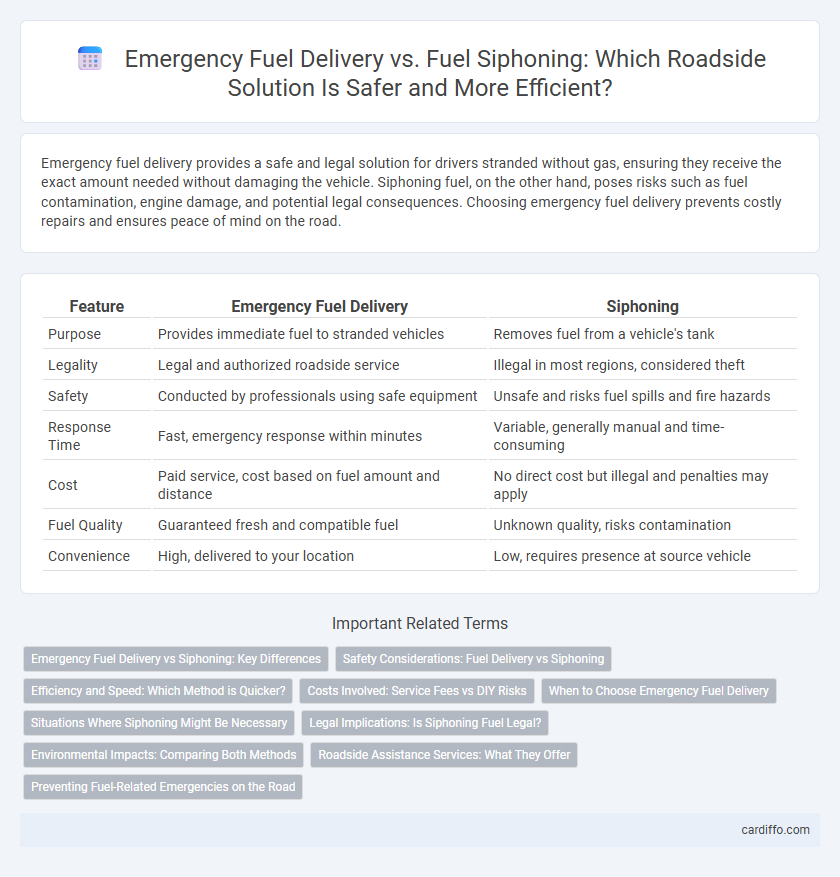Emergency fuel delivery provides a safe and legal solution for drivers stranded without gas, ensuring they receive the exact amount needed without damaging the vehicle. Siphoning fuel, on the other hand, poses risks such as fuel contamination, engine damage, and potential legal consequences. Choosing emergency fuel delivery prevents costly repairs and ensures peace of mind on the road.
Table of Comparison
| Feature | Emergency Fuel Delivery | Siphoning |
|---|---|---|
| Purpose | Provides immediate fuel to stranded vehicles | Removes fuel from a vehicle's tank |
| Legality | Legal and authorized roadside service | Illegal in most regions, considered theft |
| Safety | Conducted by professionals using safe equipment | Unsafe and risks fuel spills and fire hazards |
| Response Time | Fast, emergency response within minutes | Variable, generally manual and time-consuming |
| Cost | Paid service, cost based on fuel amount and distance | No direct cost but illegal and penalties may apply |
| Fuel Quality | Guaranteed fresh and compatible fuel | Unknown quality, risks contamination |
| Convenience | High, delivered to your location | Low, requires presence at source vehicle |
Emergency Fuel Delivery vs Siphoning: Key Differences
Emergency fuel delivery provides a reliable and legal method to access fuel when stranded, using professional assistance to refuel the vehicle safely and efficiently. Siphoning involves illegally extracting fuel from another vehicle, risking damage, theft charges, and potential injury due to improper techniques. The key difference lies in emergency fuel delivery's safety, legality, and convenience compared to the hazards and illegality associated with siphoning.
Safety Considerations: Fuel Delivery vs Siphoning
Emergency fuel delivery prioritizes safety through the use of certified containers and trained professionals to minimize fire hazards and fuel spills during refueling. Siphoning poses significant risks including exposure to toxic fumes, potential ingestion of contaminants, and environmental pollution due to uncontrolled fuel transfer. Opting for emergency fuel delivery ensures compliance with safety regulations and reduces the likelihood of accidents compared to the hazardous practice of siphoning.
Efficiency and Speed: Which Method is Quicker?
Emergency fuel delivery services provide rapid and efficient refueling directly at the roadside, eliminating wait times associated with siphoning and reducing vehicle downtime significantly. Siphoning fuel manually is often slower, riskier, and less reliable due to potential fuel spillage and equipment requirements. Professional fuel delivery ensures a quicker resolution by bypassing these challenges and delivering the precise amount of fuel needed for immediate vehicle operation.
Costs Involved: Service Fees vs DIY Risks
Emergency fuel delivery typically involves service fees ranging from $50 to $150, depending on location and fuel type, providing a safe and reliable solution without vehicle damage risk. Siphoning fuel as a DIY method may seem cost-effective initially but carries risks such as engine contamination, fuel system damage, and potential legal issues, leading to costly repairs often exceeding the cost of professional service. Choosing emergency fuel delivery ensures cost predictability and avoids the higher expenses linked to fuel siphoning damages.
When to Choose Emergency Fuel Delivery
Emergency fuel delivery is the optimal choice when a vehicle runs out of gas in an inaccessible location or during extreme weather conditions where siphoning is impractical or unsafe. Professionals performing emergency fuel delivery use clean, appropriate fuel directly compatible with the vehicle's engine, minimizing risk of contamination or damage. Choosing emergency fuel delivery ensures prompt, reliable service without the hazards and potential vehicle damages associated with siphoning fuel from other vehicles.
Situations Where Siphoning Might Be Necessary
In roadside emergencies where a vehicle runs out of fuel far from a service station, emergency fuel delivery is often the fastest, safest solution. However, siphoning may become necessary in remote or hazardous locations where professional fuel delivery is unavailable or delayed, allowing drivers to transfer fuel from a nearby vehicle to continue their journey. Proper siphoning techniques must be employed to avoid contamination or inhalation hazards, ensuring the temporary fuel supply is safe for engine use.
Legal Implications: Is Siphoning Fuel Legal?
Siphoning fuel from another vehicle is illegal in most jurisdictions and can lead to criminal charges such as theft or tampering with property. Emergency fuel delivery services provide a legal and safe alternative, ensuring drivers receive fuel without violating laws or risking penalties. Understanding local regulations is crucial before attempting any form of fuel transfer to avoid legal complications.
Environmental Impacts: Comparing Both Methods
Emergency fuel delivery minimizes environmental risks by providing clean fuel directly to stranded vehicles, preventing leaks and soil contamination. Siphoning poses significant hazards, often leading to fuel spillage that contaminates soil and water sources while releasing harmful volatile organic compounds into the air. Choosing professional fuel delivery services significantly reduces the ecological footprint compared to the environmentally damaging practice of siphoning.
Roadside Assistance Services: What They Offer
Emergency fuel delivery provides a safe and reliable solution for stranded motorists by delivering the exact fuel type directly to the vehicle, avoiding contamination risks associated with siphoning. Roadside assistance services offer professionally trained technicians equipped with proper safety gear and tools, ensuring quick fuel delivery without damage to the vehicle. Unlike siphoning, emergency fuel delivery maintains fuel system integrity, reduces environmental hazards, and is covered under many roadside assistance plans for added consumer protection.
Preventing Fuel-Related Emergencies on the Road
Emergency fuel delivery services provide a safe and efficient solution to prevent fuel-related emergencies on the road by supplying the exact amount of fuel needed without the risks of contamination or theft. Relying on siphoning can lead to damage to the vehicle's fuel system and potential legal consequences, increasing roadside hazards. Utilizing professional fuel delivery enhances vehicle reliability and driver safety by reducing delays and avoiding hazardous attempts to obtain fuel.
emergency fuel delivery vs siphoning Infographic

 cardiffo.com
cardiffo.com